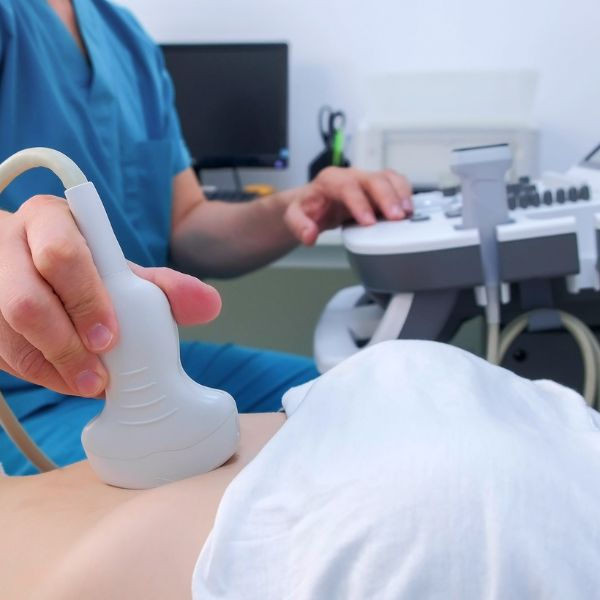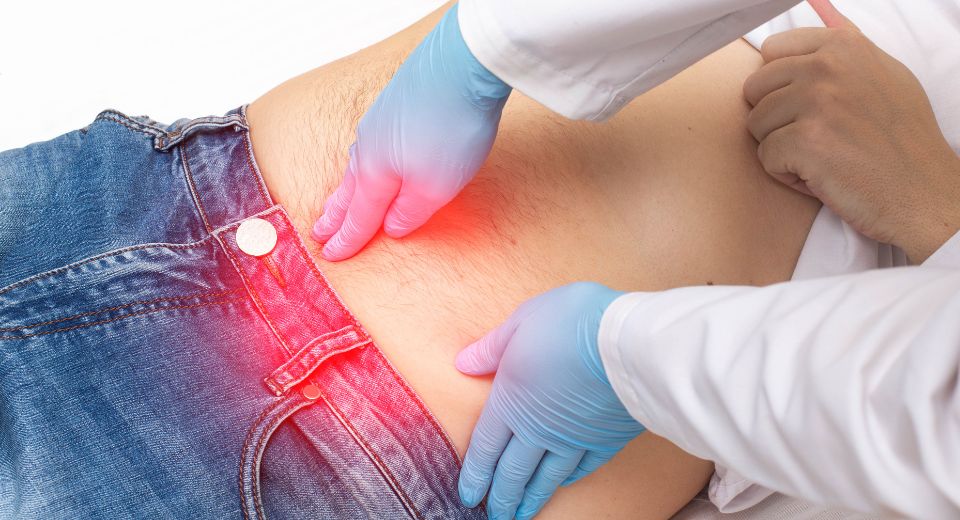
Author: Ryan Pham, PA-C
Hernias are caused by a combination of muscle weakness and strain. Depending on its cause, a hernia can develop quickly or over a long period of time. A hernia occurs when an organ pushes through an opening in the muscle or tissue that holds it in place. Many hernias occur in the abdomen between your chest and hips, but they can also appear in the upper thigh and groin areas. Most hernias aren’t immediately life threatening, but they don’t go away on their own. Sometimes they can require surgery to prevent dangerous complications.
There are several types of hernias: Inguinal, Hiatal, Umbilical, and Ventral.
- Inguinal hernias are the most common type of hernia. They occur when the intestines push through a weak spot or tear in the lower abdominal wall, often in the inguinal canal. The inguinal canal is found in your groin. In men, it’s the area where the spermatic cord passes from the abdomen to the scrotum. This cord attaches to the testicles. In women, the inguinal canal contains a ligament (called the round ligament) that helps hold the uterus in place.
- A hiatal hernia occurs when part of your stomach protrudes up through the diaphragm into your chest cavity. The diaphragm is a sheet of muscle that helps you breathe by contracting and drawing air into the lungs. It separates the organs in your abdomen from those in your chest. This type of hernia is most common in people over 50 years old. If a child has the condition, it’s typically caused by a congenital birth irregularity. Hiatal hernias almost always cause gastroesophageal reflux disease (GERD). In GERD, the stomach contents leak backward into the esophagus, causing a burning sensation.
- Umbilical hernias can affect children and babies. They occur when the intestines bulge through the abdominal wall near the belly button. You may notice a bulge in or near your child’s belly button, especially when they’re crying. An umbilical hernia is the only kind that often goes away on its own as the abdominal wall muscles get stronger. This typically happens by the time the child is 1 or 2 years old. If the hernia hasn’t gone away by 5 years of age, surgery can be performed to correct it. Adults can also have umbilical hernias. They can occur from repeated strain on the abdomen due to conditions such as obesity, fluid in the abdomen (ascites), or pregnancy.
- A ventral hernia happens when tissue bulges through an opening in the muscles of your abdomen. You may notice that a ventral hernia decreases in size when you’re lying down. Although a ventral hernia can be present from birth, it’s more commonly acquired at some point during your lifetime. Common factors in ventral hernia formation include obesity, pregnancy, and strenuous activity. Ventral hernias can also occur at the site of a surgical incision. This is called an incisional hernia and can result from surgical scarring or weakness of the abdominal muscles at the surgical site.
The most common symptom of a hernia is a bulge or lump in the affected area. For example, in the case of an inguinal hernia, you may notice a lump on either side of your pubic bone where your groin and thigh meet. You may find that the lump “disappears” when you’re lying down. You’re more likely to feel your hernia through touch when you’re standing up, bending down, or coughing. Discomfort or pain in the area around the lump may also be present.
Some types of hernia, such as hiatal hernias, can have more specific symptoms. These can include heartburn, trouble swallowing, and chest pain. In many cases, hernias have no symptoms. You may not know you have a hernia unless it shows up while you’re undergoing a medical exam for an unrelated problem or a routine physical.
Hernias are caused by a combination of muscle weakness and strain. Depending on its cause, a hernia can develop quickly or over a long period of time.
Some common causes of muscle weakness or strain that can lead to a hernia include:
- A congenital condition, which occurs during development in the womb and is present from birth
- Aging
- Damage from an injury or surgery
- Strenuous exercise or lifting heavy weights
- Chronic coughing or chronic obstructive pulmonary disorder (COPD)
- Pregnancy, especially having multiple pregnancies
- Constipation, which causes you to strain when having a bowel movement
- Being overweight or having obesity
There are also certain risk factors that make you more likely to develop a hernia. They include:
- Being born prematurely or having a low birth weight
- Being older
- Chronic cough (likely due to the repetitive increase in abdominal pressure)
- Cystic fibrosis
- Pregnancy
- Chronic constipation
- Being overweight or having obesity
- Smoking, which leads to the weakening of connective tissue
- A personal or family history of hernias

- Abdominal ultrasound. Abdominal ultrasound uses high-frequency sound waves to create an image of the structures inside the body.
- Abdominal CT scan. Abdominal CT scan combines X-rays with computer technology to produce an image.
- Abdominal MRI scan. Abdominal MRI scan uses a combination of strong magnets and radio waves to create an image.
The only way to effectively treat a hernia is through surgical repair. Whether or not you need surgery depends on the size of your hernia and the severity of your symptoms. Your doctor may want to simply monitor your hernia for possible complications. This approach is called watchful waiting. In some cases, wearing a truss may help to ease the symptoms of a hernia. A truss is a supportive undergarment that helps to hold the hernia in place. Always see your doctor to make sure that a truss fits properly before using it.
You can’t always prevent a hernia from developing. Sometimes a hernia occurs because of an existing inherited condition or a previous surgery. However, you can make some simple lifestyle adjustments to help lower your risk of a hernia. These steps aim to reduce the amount of strain you place on your body.
Here are a few general prevention tips:
- If you smoke, consider quitting. You can work with your doctor to create a smoking cessation plan that’s right for you.
- See a doctor when you’re sick to avoid developing a persistent cough.
- Maintain a moderate body weight.
- Try not to strain while having a bowel movement or during urination.
- Eat enough high fiber foods to prevent constipation.
- Perform exercises that help to strengthen the muscles of your abdomen.
- Avoid lifting weights that are too heavy for you. If you must lift something heavy, bend at your knees and not your waist or back. Also avoid holding your breath when lifting heavy objects. Instead, exhale during the lift to decrease the chance of a hiatal hernia happening or worsening.
The information provided is for general interest only and should not be misconstrued as a diagnosis, prognosis, or treatment recommendation. This information does not in any way constitute the practice of medicine, or any other health care profession. Readers are directed to consult their health care provider regarding their specific health situation. Marque Medical is not liable for any action taken by a reader based upon this information.

